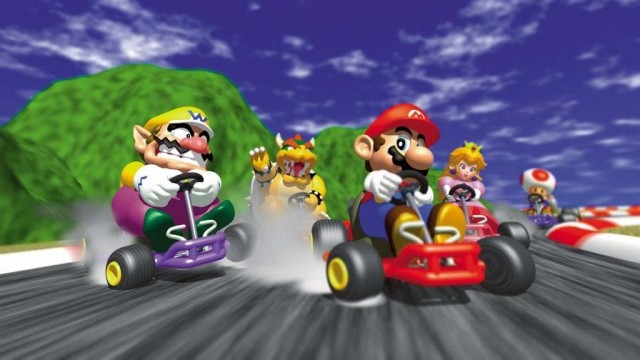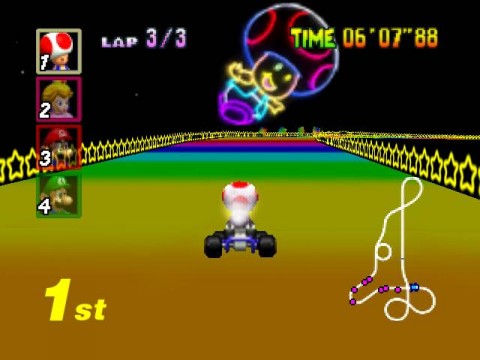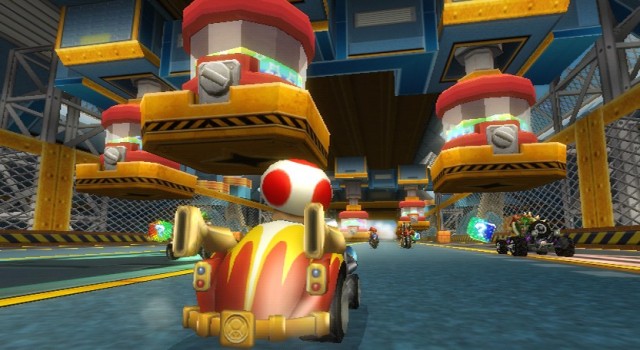
There’s a certain balancing act that video game franchises must achieve in order to be successful. On one hand, if you stay the course too much, you end up boring the fans. On the other, if you change things too much, you may end up alienating the fans. While sometimes it can work if you stay the course or go way too different, it’s not always the case. The balancing act is what keeps things fresh and fun.
Mario Kart is probably one of the most adept at evolving without going too crazy. Each iteration of the series has managed to add something into the mix to keep them fresh and interesting. While there are some changes that didn’t quite pan out, others have withstood the test of time and proved to be worthwhile additions into the franchise’s ever changing format.
In its roots as Super Mario Kart, we are given the bare bones of what this franchise could achieve. We started off with eight racers (Mario, Luigi, Peach, Toad, Yoshi, Koopa Troopa, Donkey Kong Jr., and Bowser) and four cups (Mushroom, Flower, Star, and Special). The courses were very standard and had such uncreative names as “Donut Plains 2,” “Mario Circuit 3,” and “Koopa Beach 1,” which isn’t entirely terrible. And the items we were given had a decent variety including such mainstays as Green Shells, Banana Peels, and Starmen. We were also given a very samba-inspired soundtrack with whistles and polyrhythmic beats. It was a fun little game that was a nice time waster, but most folks probably didn’t think it’d escalate into what it is today.
Then came Mario Kart 64, which upped the ante. Many consider this one to be the best of the entire franchise, which isn’t entirely wrong. It’s definitely the one that shaped the franchise into what it is today the most. It still featured eight players (with Wario replacing Koopa Troopa and Donkey Kong replacing Donkey Kong Jr.) and 20 courses. But with this version, 3D racing was implemented, which made for much more fascinating racing, and four-player multiplayer was added, which became the basis for many late nights of broken friendships and competitive spirits going haywire. More items were added, including the much hated Blue Shell, the breaker of many first place hopes. The courses were not just rehashes of the same four courses over and over again; instead, they were all unique and had their own spin to them, like Toad’s Turnpike and Moo Moo Farm. This game also began the tradition of keeping a Bowser’s Castle course and always ending with Rainbow Road.

While most would soon point to Mario Kart: Double Dash!! as the next game, they forget that there was a version for Game Boy Advance called Mario Kart: Super Circuit. This version was not well celebrated, mostly because it was pretty standard, even if it did contain one of my favorite courses to race on (Sky Garden is the best). However, something that this game did start doing was including Retro Courses. While the selection wasn’t as varied as later entries, since Nintendo only included Super Mario Kart courses, it still helped introduce a feature that carried on for future versions.
While one may argue that Mario Kart: Super Circuit didn’t change enough, that certainly is not the case for Mario Kart: Double Dash!!, which made a ton of changes to the entire format. In this version, which was released for GameCube, you were given two racers co-operating in one kart. One would handle the driving, the other handling the items. Of course, this doesn’t mean that it was a bad thing. In fact, many consider this game one of the stronger entries of the series. The number of characters increased greatly to 20, or 10 teams, which you could mix and match any way you liked, allowing for some interesting combinations. Unfortunately, the developers didn’t include retro courses and only 16 new ones were available, but they did add in something interesting. Once you finish all the cups, you are then given another cup course involving all 16 courses, like a super mega remix of sorts. Another thing that Double Dash!! did was experiment with network gameplay. Nintendo implemented co-op LAN play which allowed for people to be connected together through their GameCube systems. That would be a precursor of what would come next with the following entries in the franchise.
There was a back to basics kind of feel to Mario Kart DS, which went back to singular racers in single karts. You were treated to 12 characters (four of whom were unlockable) and 16 courses– at least, when it came to newer courses. Nintendo also brought back the retro course idea from Super Circuit, which would remain a mainstay for future editions of this franchise. Only this time, the developers mixed and matched tracks from all the past Mario Kart editions. Mario Kart DS also debuted two items: Blooper (which would mess with the screen interface) and Bullet Bill (at item that allowed players who were further behind to get ahead quickly), both of which would become quite valuable to those who would find themselves in a pinch. The biggest thing that Mario Kart DS brought to the fray, however, was the debut of online multiplayer via Wi-Fi. While Double Dash!! began the idea of network play, it was Mario Kart DS that changed everything with its debut of online multiplayer. Now, you could spend hours on end racing with people from all around the world to claim your global superiority.
For some reason, many folks are not as fond of Mario Kart Wii as I initially thought. Sure, the game has its downfalls, but Nintendo was at least trying something different with the installment. Perhaps it was the motion controls that really brings people’s opinion of the game down, which is fairly reasonable. However, the developers did add in a lot of interesting things in the mix. Motion controls could be difficult to master, but it was something new to the series. There was also the debut of motorbikes as well, which people either really like or really hate. There seems to be no middle ground there. However, the expansion from eight to 12 racers was actually a lot more fun in online mode. It made finding a group of racers much easier and also helped up the ante on one’s mission to claim their global superiority… or national superiority if they wanted to stay within their own country. With the expansion of racers, this also increased the roster to 24 characters (12 of whom had to be unlocked). The Wii version may not be as popular with some folks, but it’s far from the worst of the bunch.

And now we get to the most recent game in the franchise, Mario Kart 7 for 3DS. Thankfully, Nintendo decided to start numbering the games instead of using the system that they’re on as part of their title. While some may argue that Mario Kart 64 was the most evolutionary, I think it’s actually a tie with this game. Yeah, the basics weren’t as dramatically changed, but the ways that you could race were extremely different and made for a ton of interesting combinations. The number of racers in this version went down from 12 to eight; however, you did have 17 racers at your disposal (five of whom were unlockable, including your Mii). Despite the strange absence of Waluigi (which is not explained at all), the characters Nintendo did add in were well worth it, including a chance for Lakitu to race! After all that time he had to fish out players who fell into the water, he was finally given a chance to shine on the racetrack. You are given two things that made the way you raced in this game super fun: the glider and the ability to go underwater. Being able to race underwater with these karts has proved to be extremely fun in a lot of cases with courses such as Piranha Plant Slide and Cheep Cheep Lagoon. The glider could help you in a bind and, combined with the mushroom, could help you cheat and cut across hairy parts of some courses and get ahead in the standings. With the advent of these two things, this also became the first game in which you can customize your karts in any way you want. You want the Swooper Glider with the Bumble V kart and wooden wheels? You got it! So long as you unlocked all of those parts, it’s no problemo. These additions were welcomed warmly and seemed to have carried on into the upcoming Mario Kart game.
There have been many changes in the Mario Kart franchise that tried to make the game much more interesting and fresh to longtime fans without completely abandoning the formula that made them successful in the first place. Some of these changes have stuck while others were abandoned, but the one thing that does remain is that no matter how much has changed, the franchise is still at its base a very fun kart racer that was much more enjoyable against friends and family… so long as no blue shells are around (then you may get some serious familial estrangement or broken friendships). With the arrival of Mario Kart 8, we will see some more changes like the debut of anti-gravity, HD graphics, and the ability to upload your greatest videos onto YouTube if you’d like. These changes seem to be well embraced, but we’ll see exactly how these will fare.
But until then, let’s raise our controllers to Mario Kart. May its evolutions always stay true to the series’ roots for years to come.




 ShareThis
ShareThis







Did the lack of hopping in Double Dash make the game feel wrong to anyone else? The drifting and everything were all still there, but without that little initial jump, that game just never felt right to me.